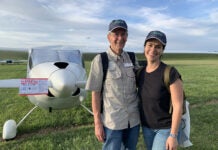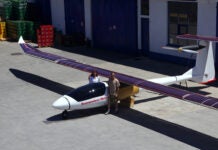
Monday October 3 marked the Green Flight Challenge Expo, sponsored by Google and staged under the control tower at the center of Moffett Field, home of NASA Ames Research Center.
The four airplanes that flew in the Green Flight Challenge at Charles M. Schulz Sonoma Country Airport in Santa Rosa, California, were there, along with Greg Stevenson’s full-size mockup of his GFC design and a Pipistrel Virus that had won an earler NASA/CAFE Personal Air Vehicle (PAV) Challenge.
Twenty exhibitors were on hand to show their approaches to green aviation, and three rows of tents protected exhibitors and their displays from the rain that started mid-afternoon. At about 11 a.m., attendees were brought to Building 3, in which NASA’s acting Chief Technical Officer Joe Parrish recognized the GFC winners.

In opening remarks, Brien Seeley, head of the CAFE Foundation, said he saw this as a “pivotal historic event,” with future aerial vehicles quiet, emissions free and capable of landing anywhere—in other words, achieving bird-like flight.
Erik Lindbergh of the Lindbergh Electric Aircraft Prize awarded a $10,000 prize to team leader Eric Raymond and e-Genius for the quietest aircraft. Raymond’s e-Genius registered between 56 and 62 dBa during the takeoff tests on Monday. Compare this to normal conversation, which might range between 80 to 85 dBa.
Recounting other prizes that had produced significant outcomes, Parrish named the Orteig and Ansari X-Prizes, and said he thinks that the GFC will inspire a renaissance in aircraft technology, noting that NASA and the American taxpayer benefited from funding for such prizes, whereas NASA “only pays if it works.”
He explained that NASA’s $1.6 million investment had generated of $4 million in expenditures by competitors and produced two stunning results, the winners of the Challenge.

e-Genius took a second prize of $120,000 along with the Lindbergh noise prize of $10,000 (prize money donated by Charles Schulz’s widow Jeannie Schulz). Both it and the Pipistrel G-4 had flown the 200-mile course at better than 100 mph average and wildly exceeded the required 200 passenger miles per gallon (pmpg) economy goal; e-Genius reach 375.8 passenger miles per gallon. The G-4 did even better at 403.5 pmpg.
 The winner received not only monetary compensation, but a glorious trophy designed by Brien Seeley’s wife Anne, his son Damon and Bruno Mombrinie, a CAFE board member; it was sculpted by local artist Ralph Carlson.
The winner received not only monetary compensation, but a glorious trophy designed by Brien Seeley’s wife Anne, his son Damon and Bruno Mombrinie, a CAFE board member; it was sculpted by local artist Ralph Carlson.
Jack Langelann, Pennsylvania State aeronautics professor and Pipistrel team leader, explained that at the current 8 cents per kilowatt hour charge in his home state, the G-4 could be charged for a two-hour flight at a cost of $7.
This may have been even less costly in recharging from the CAFE Foundation’s special charging stations, installed just for the event. Receiving their electricity from geothermal-powered generators on nearby peaks in the Geyserville area, CAFE’s fliers flew “green” indeed.
Following the awards ceremony, covered by all of the local network news media, the teams each performed fly-bys for the gathered throng, with rain finally putting an end to a gala day.











